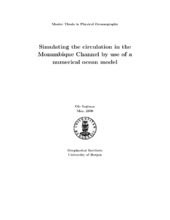Simulating the circulation in the Mozambique Channel by use of a numerical ocean model
Master thesis
Permanent lenke
https://hdl.handle.net/1956/1495Utgivelsesdato
2006-05Metadata
Vis full innførselSamlinger
- Geophysical Institute [1187]
Sammendrag
The circulation in the Mozambique Channel for the year 2002 has been studied through model results from the Regional Oceanic Modeling System (ROMS). The model has been run with both adaptive boundary conditions and values at the open boundaries fixed to climatology. Modeled anticyclonic eddies are generated at the northern tip of Madagascar. The migration of these eddies is mostly dependent on the background flow and to a less extend eddies' self induced motion. When conditions at the open boundaries are fixed to climatology the boundaries strongly constrain the background flow, by reflections of the flow at the southern open boundary. With boundary values fixed to climatology the modeled mean volume transport in the upper 500 m depth through the Mozambique Channel for the simulated year 2002, at 17°S is 1.7 Sv northward, while when adaptive boundary conditions are used, the modeled mean volume transport is -3.1 Sv, which is in agreement with observations. It is found that modeled eddies north of Madagascar are generated mainly by baroclinic instability at an approximately 15 days period. This is not seen in satellite observations and is most likely due to too strong density stratification. In both runs formation of anticyclones at a 50 days period also occur, probably related to barotropic instability of the South Equatorial Current. Generation of anticyclonic eddies at a 90 days period, possibly induced by westward travelling Rossby waves, are seen when values are fixed to climatology, but not when adaptive boundary conditions are applied.
Utgiver
The University of BergenOpphavsrett
The authorCopyright the author. All rights reserved
